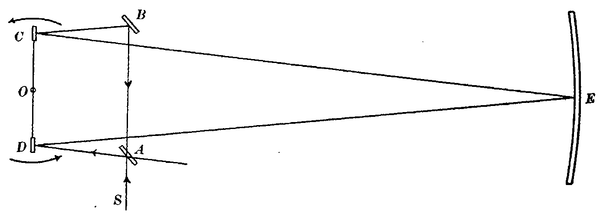EFFECT OF REFLECTION FROM A MOVING MIRROR
ON THE VELOCITY OF LIGHT
BY A. A. MICHELSON
According to the undulatory theory of light the velocity of light is independent of the velocity of the source, and of the velocity of a mirror at which it is reflected.
According to the emission theory the resultant velocity from a moving source is increased by the component of the velocity of the source. But it appears that different forms of emission theory require different results on reflection from a moving mirror. If the light corpuscles are reflected as projectiles from an elastic wall, then the velocity of light should be increased by twice the component of the velocity of the mirror.[1]
The following arrangement was devised for the purpose of deciding the question experimentally.

Fig. 1.—Diagram of apparatus
Light from a source at S falls on a lightly silvered mirror A. The reflected pencil goes to a revolving mirror D, thence to the concave mirror E, to the second mirror C revolving about the same axis O, whence it proceeds to the plane mirror B and is reflected back to A. The transmitted pencil pursues the same path in the
- ↑ An alternative hypothesis, that the velocity of light should be increased by the component of the velocity of the mirror, is suggested by R. C. Tolman but shown to be inadmissible. (R. C. Tolman, "Some Emission Theories of Light," Physical Review, August 1912).
